Project Risk, Financing, and Monitoring: Hudson Yards Analysis
VerifiedAdded on 2023/01/20
|17
|3820
|86
Report
AI Summary
This report provides a comprehensive risk analysis and mitigation plan for the Hudson Yards project, a large-scale real estate development in New York City. The analysis begins with an overview of the project, including its budget, social and economic rationale, key statistics, funding mechanisms, and identification of key stakeholders. Part B focuses on a detailed risk analysis, employing both qualitative and quantitative methods, including PMBOK risk analysis and the development of a risk matrix to assess the likelihood and severity of identified risks. The report identifies key risks such as design constraints, operational issues, schedule risks, and budget risks. Finally, Part C outlines a risk mitigation plan, proposing strategies to address and minimize the impact of these identified risks, ensuring the project's successful completion. The report provides valuable insights into project management, risk assessment, and the complexities of large-scale infrastructure projects.
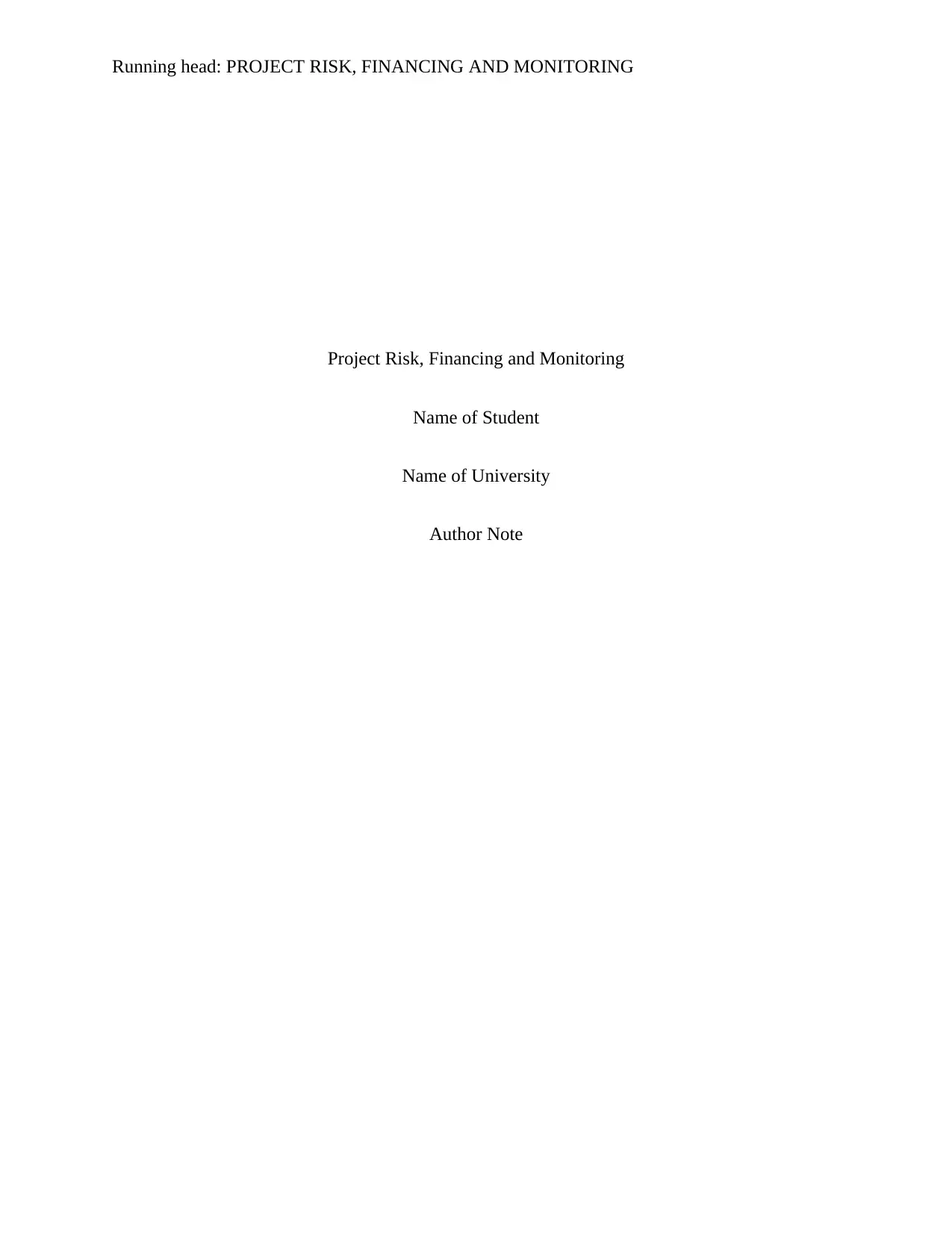
Running head: PROJECT RISK, FINANCING AND MONITORING
Project Risk, Financing and Monitoring
Name of Student
Name of University
Author Note
Project Risk, Financing and Monitoring
Name of Student
Name of University
Author Note
Paraphrase This Document
Need a fresh take? Get an instant paraphrase of this document with our AI Paraphraser
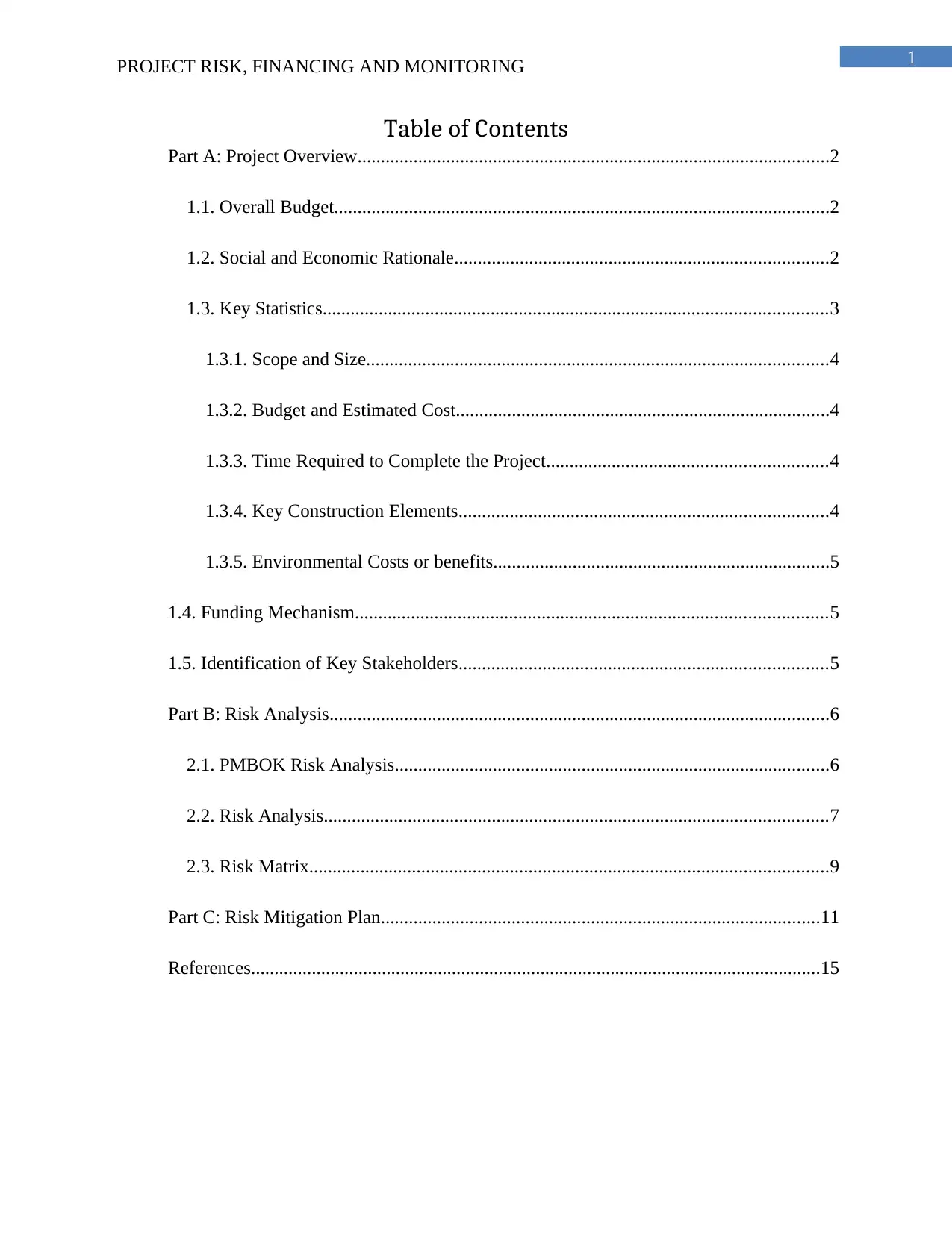
1PROJECT RISK, FINANCING AND MONITORING
Table of Contents
Part A: Project Overview.....................................................................................................2
1.1. Overall Budget..........................................................................................................2
1.2. Social and Economic Rationale................................................................................2
1.3. Key Statistics............................................................................................................3
1.3.1. Scope and Size...................................................................................................4
1.3.2. Budget and Estimated Cost................................................................................4
1.3.3. Time Required to Complete the Project............................................................4
1.3.4. Key Construction Elements...............................................................................4
1.3.5. Environmental Costs or benefits........................................................................5
1.4. Funding Mechanism.....................................................................................................5
1.5. Identification of Key Stakeholders...............................................................................5
Part B: Risk Analysis...........................................................................................................6
2.1. PMBOK Risk Analysis.............................................................................................6
2.2. Risk Analysis............................................................................................................7
2.3. Risk Matrix...............................................................................................................9
Part C: Risk Mitigation Plan..............................................................................................11
References..........................................................................................................................15
Table of Contents
Part A: Project Overview.....................................................................................................2
1.1. Overall Budget..........................................................................................................2
1.2. Social and Economic Rationale................................................................................2
1.3. Key Statistics............................................................................................................3
1.3.1. Scope and Size...................................................................................................4
1.3.2. Budget and Estimated Cost................................................................................4
1.3.3. Time Required to Complete the Project............................................................4
1.3.4. Key Construction Elements...............................................................................4
1.3.5. Environmental Costs or benefits........................................................................5
1.4. Funding Mechanism.....................................................................................................5
1.5. Identification of Key Stakeholders...............................................................................5
Part B: Risk Analysis...........................................................................................................6
2.1. PMBOK Risk Analysis.............................................................................................6
2.2. Risk Analysis............................................................................................................7
2.3. Risk Matrix...............................................................................................................9
Part C: Risk Mitigation Plan..............................................................................................11
References..........................................................................................................................15
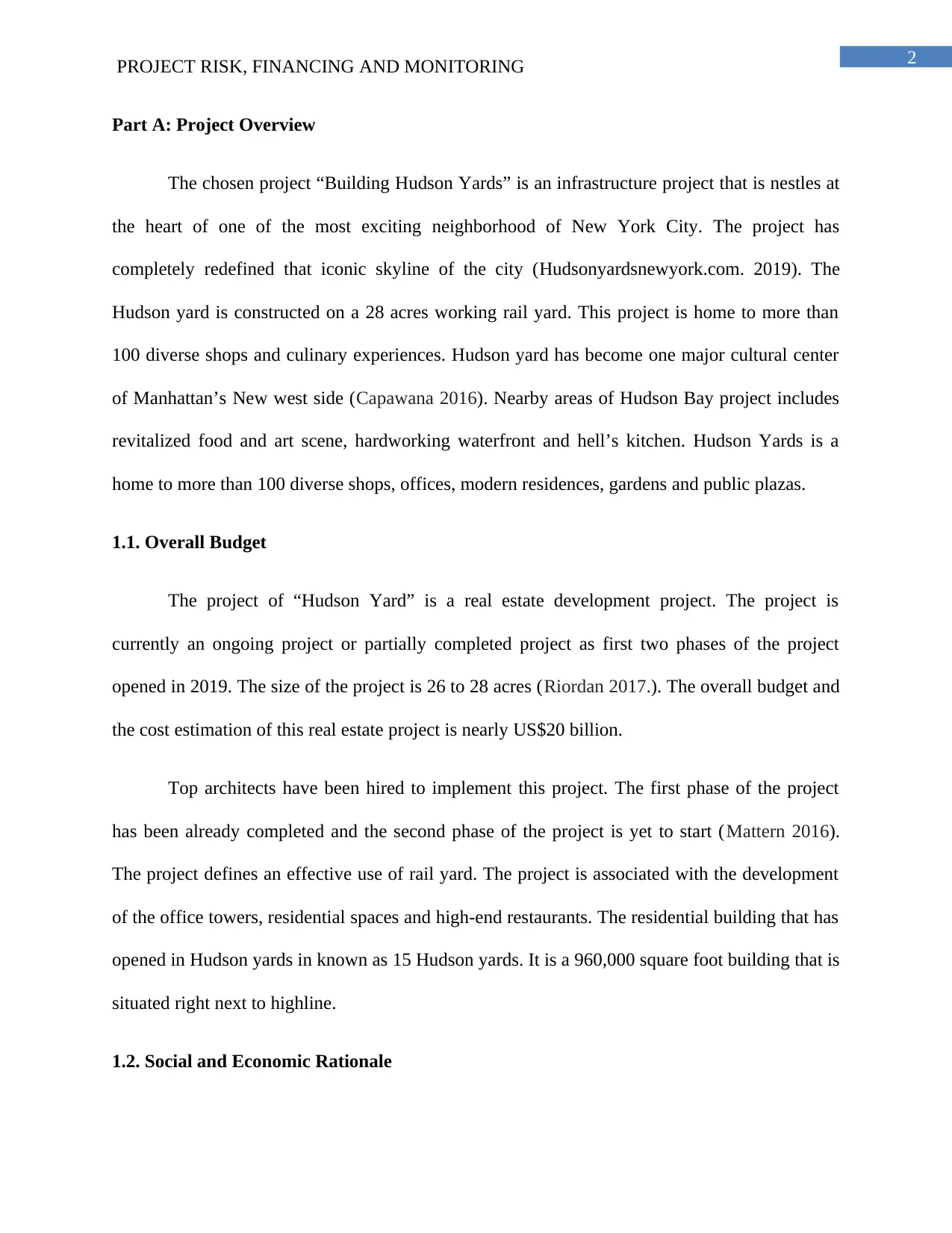
2PROJECT RISK, FINANCING AND MONITORING
Part A: Project Overview
The chosen project “Building Hudson Yards” is an infrastructure project that is nestles at
the heart of one of the most exciting neighborhood of New York City. The project has
completely redefined that iconic skyline of the city (Hudsonyardsnewyork.com. 2019). The
Hudson yard is constructed on a 28 acres working rail yard. This project is home to more than
100 diverse shops and culinary experiences. Hudson yard has become one major cultural center
of Manhattan’s New west side (Capawana 2016). Nearby areas of Hudson Bay project includes
revitalized food and art scene, hardworking waterfront and hell’s kitchen. Hudson Yards is a
home to more than 100 diverse shops, offices, modern residences, gardens and public plazas.
1.1. Overall Budget
The project of “Hudson Yard” is a real estate development project. The project is
currently an ongoing project or partially completed project as first two phases of the project
opened in 2019. The size of the project is 26 to 28 acres (Riordan 2017.). The overall budget and
the cost estimation of this real estate project is nearly US$20 billion.
Top architects have been hired to implement this project. The first phase of the project
has been already completed and the second phase of the project is yet to start (Mattern 2016).
The project defines an effective use of rail yard. The project is associated with the development
of the office towers, residential spaces and high-end restaurants. The residential building that has
opened in Hudson yards in known as 15 Hudson yards. It is a 960,000 square foot building that is
situated right next to highline.
1.2. Social and Economic Rationale
Part A: Project Overview
The chosen project “Building Hudson Yards” is an infrastructure project that is nestles at
the heart of one of the most exciting neighborhood of New York City. The project has
completely redefined that iconic skyline of the city (Hudsonyardsnewyork.com. 2019). The
Hudson yard is constructed on a 28 acres working rail yard. This project is home to more than
100 diverse shops and culinary experiences. Hudson yard has become one major cultural center
of Manhattan’s New west side (Capawana 2016). Nearby areas of Hudson Bay project includes
revitalized food and art scene, hardworking waterfront and hell’s kitchen. Hudson Yards is a
home to more than 100 diverse shops, offices, modern residences, gardens and public plazas.
1.1. Overall Budget
The project of “Hudson Yard” is a real estate development project. The project is
currently an ongoing project or partially completed project as first two phases of the project
opened in 2019. The size of the project is 26 to 28 acres (Riordan 2017.). The overall budget and
the cost estimation of this real estate project is nearly US$20 billion.
Top architects have been hired to implement this project. The first phase of the project
has been already completed and the second phase of the project is yet to start (Mattern 2016).
The project defines an effective use of rail yard. The project is associated with the development
of the office towers, residential spaces and high-end restaurants. The residential building that has
opened in Hudson yards in known as 15 Hudson yards. It is a 960,000 square foot building that is
situated right next to highline.
1.2. Social and Economic Rationale
⊘ This is a preview!⊘
Do you want full access?
Subscribe today to unlock all pages.

Trusted by 1+ million students worldwide
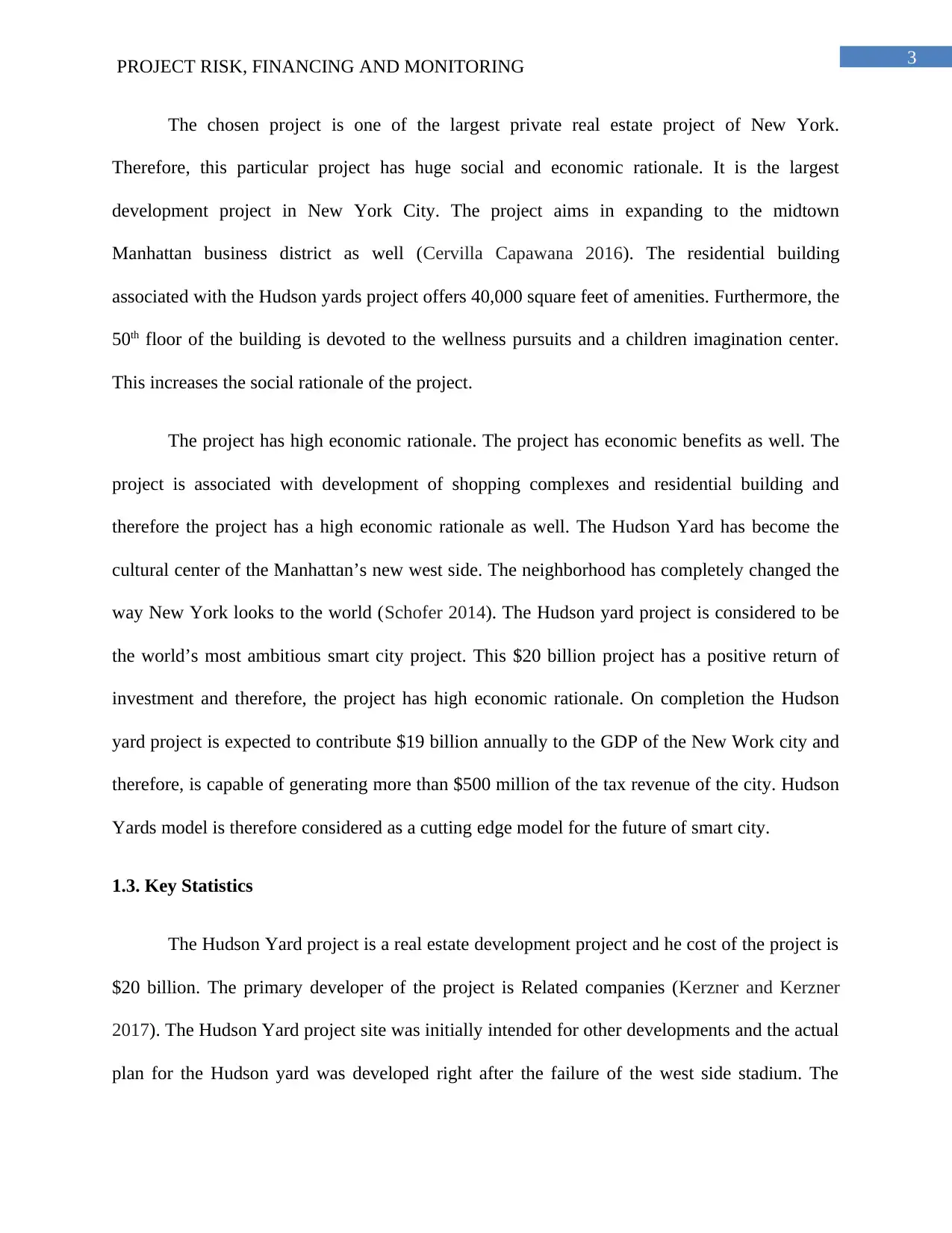
3PROJECT RISK, FINANCING AND MONITORING
The chosen project is one of the largest private real estate project of New York.
Therefore, this particular project has huge social and economic rationale. It is the largest
development project in New York City. The project aims in expanding to the midtown
Manhattan business district as well (Cervilla Capawana 2016). The residential building
associated with the Hudson yards project offers 40,000 square feet of amenities. Furthermore, the
50th floor of the building is devoted to the wellness pursuits and a children imagination center.
This increases the social rationale of the project.
The project has high economic rationale. The project has economic benefits as well. The
project is associated with development of shopping complexes and residential building and
therefore the project has a high economic rationale as well. The Hudson Yard has become the
cultural center of the Manhattan’s new west side. The neighborhood has completely changed the
way New York looks to the world (Schofer 2014). The Hudson yard project is considered to be
the world’s most ambitious smart city project. This $20 billion project has a positive return of
investment and therefore, the project has high economic rationale. On completion the Hudson
yard project is expected to contribute $19 billion annually to the GDP of the New Work city and
therefore, is capable of generating more than $500 million of the tax revenue of the city. Hudson
Yards model is therefore considered as a cutting edge model for the future of smart city.
1.3. Key Statistics
The Hudson Yard project is a real estate development project and he cost of the project is
$20 billion. The primary developer of the project is Related companies (Kerzner and Kerzner
2017). The Hudson Yard project site was initially intended for other developments and the actual
plan for the Hudson yard was developed right after the failure of the west side stadium. The
The chosen project is one of the largest private real estate project of New York.
Therefore, this particular project has huge social and economic rationale. It is the largest
development project in New York City. The project aims in expanding to the midtown
Manhattan business district as well (Cervilla Capawana 2016). The residential building
associated with the Hudson yards project offers 40,000 square feet of amenities. Furthermore, the
50th floor of the building is devoted to the wellness pursuits and a children imagination center.
This increases the social rationale of the project.
The project has high economic rationale. The project has economic benefits as well. The
project is associated with development of shopping complexes and residential building and
therefore the project has a high economic rationale as well. The Hudson Yard has become the
cultural center of the Manhattan’s new west side. The neighborhood has completely changed the
way New York looks to the world (Schofer 2014). The Hudson yard project is considered to be
the world’s most ambitious smart city project. This $20 billion project has a positive return of
investment and therefore, the project has high economic rationale. On completion the Hudson
yard project is expected to contribute $19 billion annually to the GDP of the New Work city and
therefore, is capable of generating more than $500 million of the tax revenue of the city. Hudson
Yards model is therefore considered as a cutting edge model for the future of smart city.
1.3. Key Statistics
The Hudson Yard project is a real estate development project and he cost of the project is
$20 billion. The primary developer of the project is Related companies (Kerzner and Kerzner
2017). The Hudson Yard project site was initially intended for other developments and the actual
plan for the Hudson yard was developed right after the failure of the west side stadium. The
Paraphrase This Document
Need a fresh take? Get an instant paraphrase of this document with our AI Paraphraser
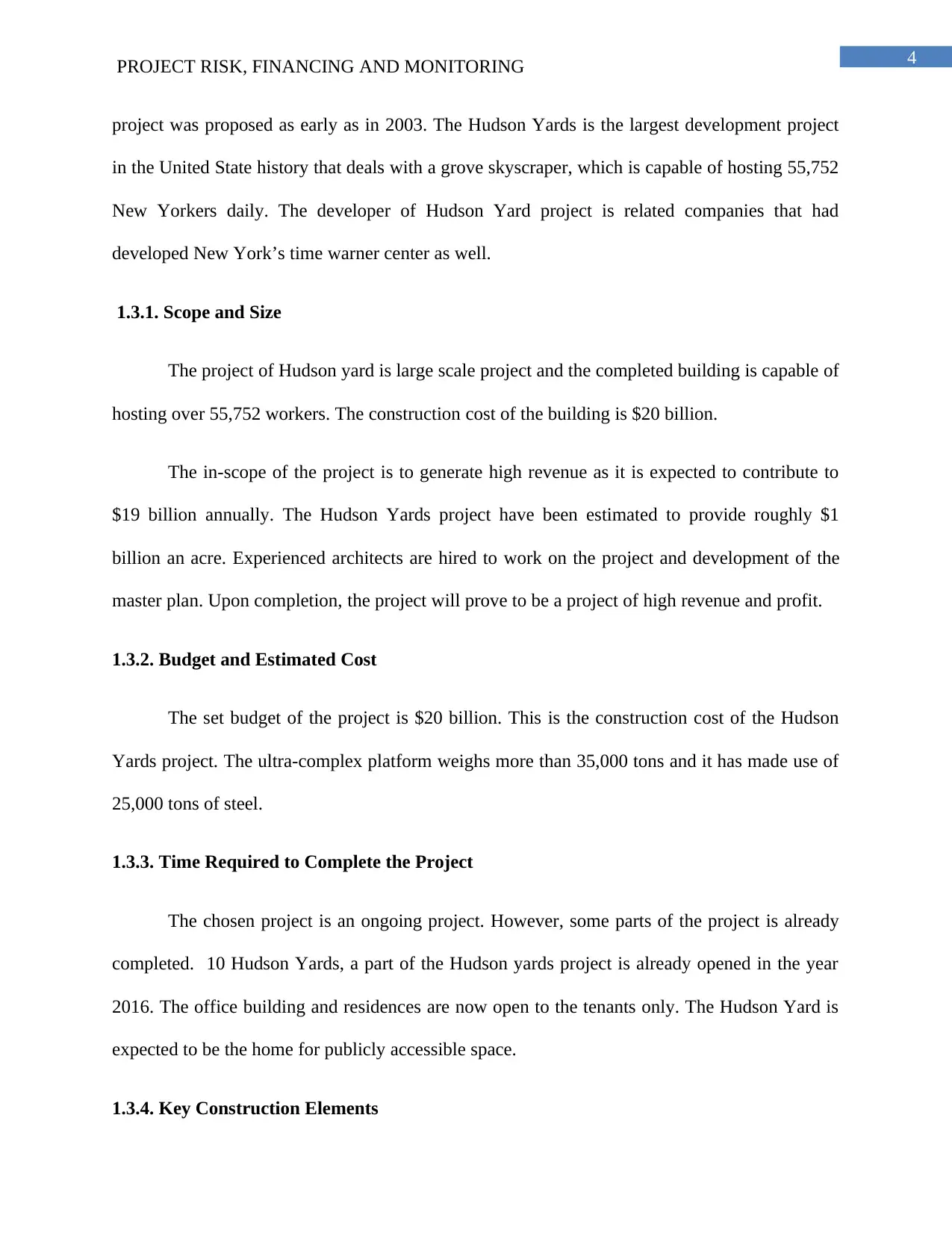
4PROJECT RISK, FINANCING AND MONITORING
project was proposed as early as in 2003. The Hudson Yards is the largest development project
in the United State history that deals with a grove skyscraper, which is capable of hosting 55,752
New Yorkers daily. The developer of Hudson Yard project is related companies that had
developed New York’s time warner center as well.
1.3.1. Scope and Size
The project of Hudson yard is large scale project and the completed building is capable of
hosting over 55,752 workers. The construction cost of the building is $20 billion.
The in-scope of the project is to generate high revenue as it is expected to contribute to
$19 billion annually. The Hudson Yards project have been estimated to provide roughly $1
billion an acre. Experienced architects are hired to work on the project and development of the
master plan. Upon completion, the project will prove to be a project of high revenue and profit.
1.3.2. Budget and Estimated Cost
The set budget of the project is $20 billion. This is the construction cost of the Hudson
Yards project. The ultra-complex platform weighs more than 35,000 tons and it has made use of
25,000 tons of steel.
1.3.3. Time Required to Complete the Project
The chosen project is an ongoing project. However, some parts of the project is already
completed. 10 Hudson Yards, a part of the Hudson yards project is already opened in the year
2016. The office building and residences are now open to the tenants only. The Hudson Yard is
expected to be the home for publicly accessible space.
1.3.4. Key Construction Elements
project was proposed as early as in 2003. The Hudson Yards is the largest development project
in the United State history that deals with a grove skyscraper, which is capable of hosting 55,752
New Yorkers daily. The developer of Hudson Yard project is related companies that had
developed New York’s time warner center as well.
1.3.1. Scope and Size
The project of Hudson yard is large scale project and the completed building is capable of
hosting over 55,752 workers. The construction cost of the building is $20 billion.
The in-scope of the project is to generate high revenue as it is expected to contribute to
$19 billion annually. The Hudson Yards project have been estimated to provide roughly $1
billion an acre. Experienced architects are hired to work on the project and development of the
master plan. Upon completion, the project will prove to be a project of high revenue and profit.
1.3.2. Budget and Estimated Cost
The set budget of the project is $20 billion. This is the construction cost of the Hudson
Yards project. The ultra-complex platform weighs more than 35,000 tons and it has made use of
25,000 tons of steel.
1.3.3. Time Required to Complete the Project
The chosen project is an ongoing project. However, some parts of the project is already
completed. 10 Hudson Yards, a part of the Hudson yards project is already opened in the year
2016. The office building and residences are now open to the tenants only. The Hudson Yard is
expected to be the home for publicly accessible space.
1.3.4. Key Construction Elements
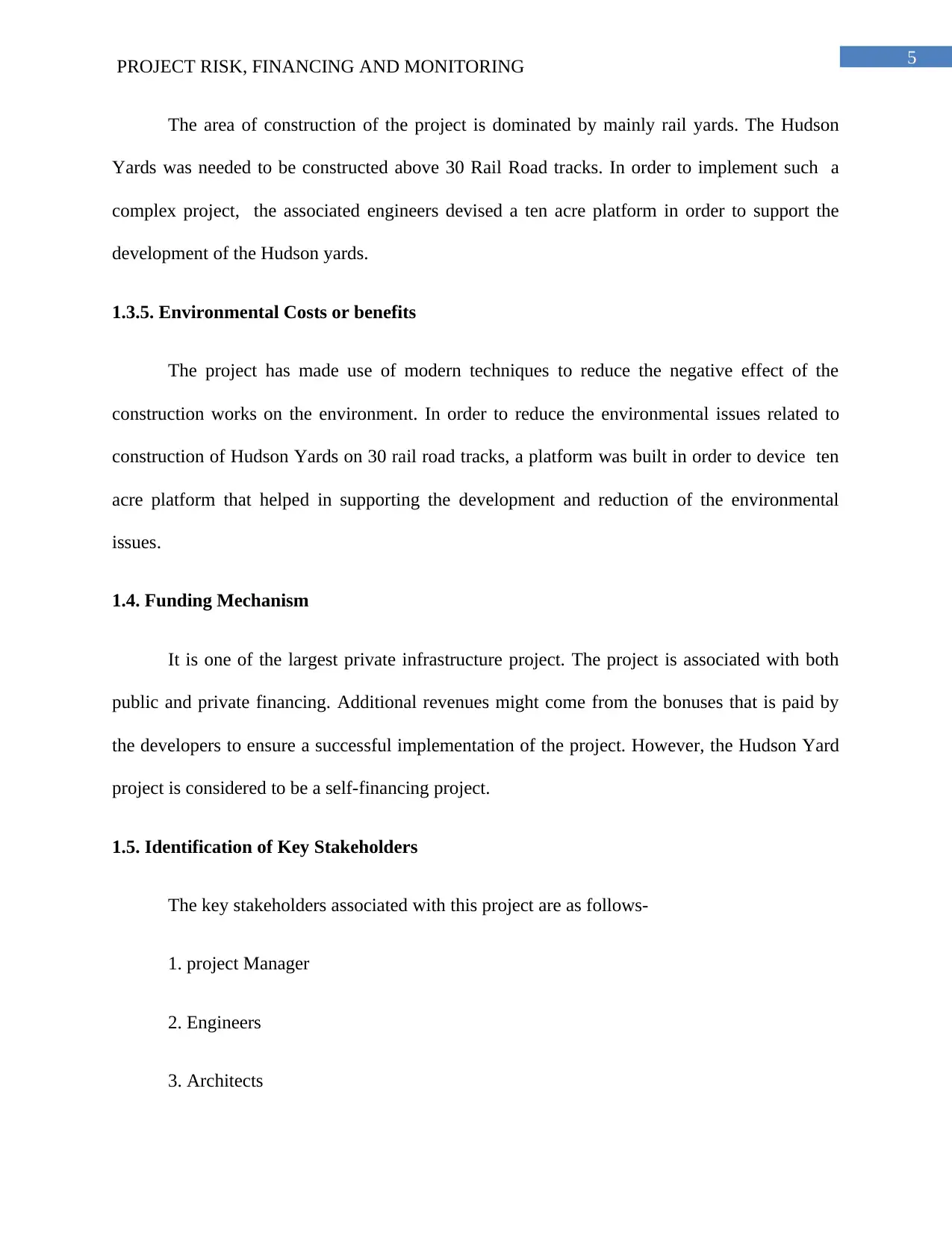
5PROJECT RISK, FINANCING AND MONITORING
The area of construction of the project is dominated by mainly rail yards. The Hudson
Yards was needed to be constructed above 30 Rail Road tracks. In order to implement such a
complex project, the associated engineers devised a ten acre platform in order to support the
development of the Hudson yards.
1.3.5. Environmental Costs or benefits
The project has made use of modern techniques to reduce the negative effect of the
construction works on the environment. In order to reduce the environmental issues related to
construction of Hudson Yards on 30 rail road tracks, a platform was built in order to device ten
acre platform that helped in supporting the development and reduction of the environmental
issues.
1.4. Funding Mechanism
It is one of the largest private infrastructure project. The project is associated with both
public and private financing. Additional revenues might come from the bonuses that is paid by
the developers to ensure a successful implementation of the project. However, the Hudson Yard
project is considered to be a self-financing project.
1.5. Identification of Key Stakeholders
The key stakeholders associated with this project are as follows-
1. project Manager
2. Engineers
3. Architects
The area of construction of the project is dominated by mainly rail yards. The Hudson
Yards was needed to be constructed above 30 Rail Road tracks. In order to implement such a
complex project, the associated engineers devised a ten acre platform in order to support the
development of the Hudson yards.
1.3.5. Environmental Costs or benefits
The project has made use of modern techniques to reduce the negative effect of the
construction works on the environment. In order to reduce the environmental issues related to
construction of Hudson Yards on 30 rail road tracks, a platform was built in order to device ten
acre platform that helped in supporting the development and reduction of the environmental
issues.
1.4. Funding Mechanism
It is one of the largest private infrastructure project. The project is associated with both
public and private financing. Additional revenues might come from the bonuses that is paid by
the developers to ensure a successful implementation of the project. However, the Hudson Yard
project is considered to be a self-financing project.
1.5. Identification of Key Stakeholders
The key stakeholders associated with this project are as follows-
1. project Manager
2. Engineers
3. Architects
⊘ This is a preview!⊘
Do you want full access?
Subscribe today to unlock all pages.

Trusted by 1+ million students worldwide
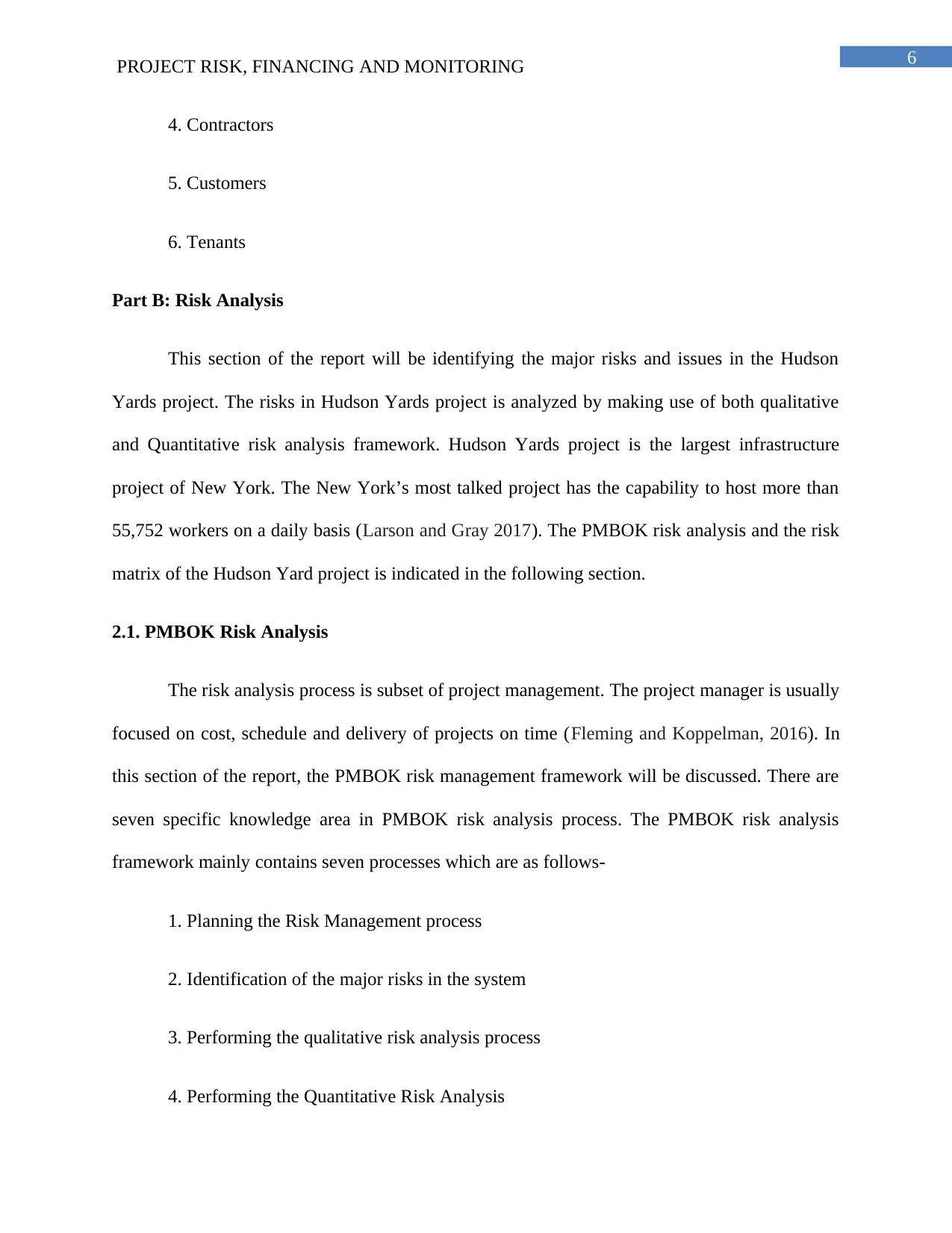
6PROJECT RISK, FINANCING AND MONITORING
4. Contractors
5. Customers
6. Tenants
Part B: Risk Analysis
This section of the report will be identifying the major risks and issues in the Hudson
Yards project. The risks in Hudson Yards project is analyzed by making use of both qualitative
and Quantitative risk analysis framework. Hudson Yards project is the largest infrastructure
project of New York. The New York’s most talked project has the capability to host more than
55,752 workers on a daily basis (Larson and Gray 2017). The PMBOK risk analysis and the risk
matrix of the Hudson Yard project is indicated in the following section.
2.1. PMBOK Risk Analysis
The risk analysis process is subset of project management. The project manager is usually
focused on cost, schedule and delivery of projects on time (Fleming and Koppelman, 2016). In
this section of the report, the PMBOK risk management framework will be discussed. There are
seven specific knowledge area in PMBOK risk analysis process. The PMBOK risk analysis
framework mainly contains seven processes which are as follows-
1. Planning the Risk Management process
2. Identification of the major risks in the system
3. Performing the qualitative risk analysis process
4. Performing the Quantitative Risk Analysis
4. Contractors
5. Customers
6. Tenants
Part B: Risk Analysis
This section of the report will be identifying the major risks and issues in the Hudson
Yards project. The risks in Hudson Yards project is analyzed by making use of both qualitative
and Quantitative risk analysis framework. Hudson Yards project is the largest infrastructure
project of New York. The New York’s most talked project has the capability to host more than
55,752 workers on a daily basis (Larson and Gray 2017). The PMBOK risk analysis and the risk
matrix of the Hudson Yard project is indicated in the following section.
2.1. PMBOK Risk Analysis
The risk analysis process is subset of project management. The project manager is usually
focused on cost, schedule and delivery of projects on time (Fleming and Koppelman, 2016). In
this section of the report, the PMBOK risk management framework will be discussed. There are
seven specific knowledge area in PMBOK risk analysis process. The PMBOK risk analysis
framework mainly contains seven processes which are as follows-
1. Planning the Risk Management process
2. Identification of the major risks in the system
3. Performing the qualitative risk analysis process
4. Performing the Quantitative Risk Analysis
Paraphrase This Document
Need a fresh take? Get an instant paraphrase of this document with our AI Paraphraser

7PROJECT RISK, FINANCING AND MONITORING
5. Planning the Risk Responses
6. Implementing the Risk Response
7. Monitoring of the identified risks.
The above discussed points indicates the major processes that are followed in risk
management of a project by making use of PMBOK risk management framework. The very first
step of risk analysis involve development of a risk management plan. A risk management plan
helps in determining the procedures for accessing and defining the risks (Walker 2015). The risk
management plan helps in better identification of the risks and issues associated with the project.
The next stage of PMBOK risk management process is Risk identification (Pritchard and PMP
2014). Identification of the potential risks and opportunities in the project is needed to prioritize
the risk on basis of the risk probability and severity.
There are a number of tools and techniques that can be used to identify and analyze the
major risks and issues associated with the project. These tools and techniques include
brainstorming, interviews and document analysis (Heagney 2016). As an output of the risk
management and assessment process risk register is delivered. The next part of PMBOK risk
analysis framework involves performing qualitative and quantitative risk analysis. As an output
of both these phases, a risk register is developed. After risk identification, it is quite necessary to
plan and implement the risk response process of the identified risk. The risk response is designed
in accordance to the severity of the identified risk and its impact on the ongoing project. The
analysis of the risk associated with the Hudson Yards project is indicated in the following
section.
2.2. Risk Analysis
5. Planning the Risk Responses
6. Implementing the Risk Response
7. Monitoring of the identified risks.
The above discussed points indicates the major processes that are followed in risk
management of a project by making use of PMBOK risk management framework. The very first
step of risk analysis involve development of a risk management plan. A risk management plan
helps in determining the procedures for accessing and defining the risks (Walker 2015). The risk
management plan helps in better identification of the risks and issues associated with the project.
The next stage of PMBOK risk management process is Risk identification (Pritchard and PMP
2014). Identification of the potential risks and opportunities in the project is needed to prioritize
the risk on basis of the risk probability and severity.
There are a number of tools and techniques that can be used to identify and analyze the
major risks and issues associated with the project. These tools and techniques include
brainstorming, interviews and document analysis (Heagney 2016). As an output of the risk
management and assessment process risk register is delivered. The next part of PMBOK risk
analysis framework involves performing qualitative and quantitative risk analysis. As an output
of both these phases, a risk register is developed. After risk identification, it is quite necessary to
plan and implement the risk response process of the identified risk. The risk response is designed
in accordance to the severity of the identified risk and its impact on the ongoing project. The
analysis of the risk associated with the Hudson Yards project is indicated in the following
section.
2.2. Risk Analysis
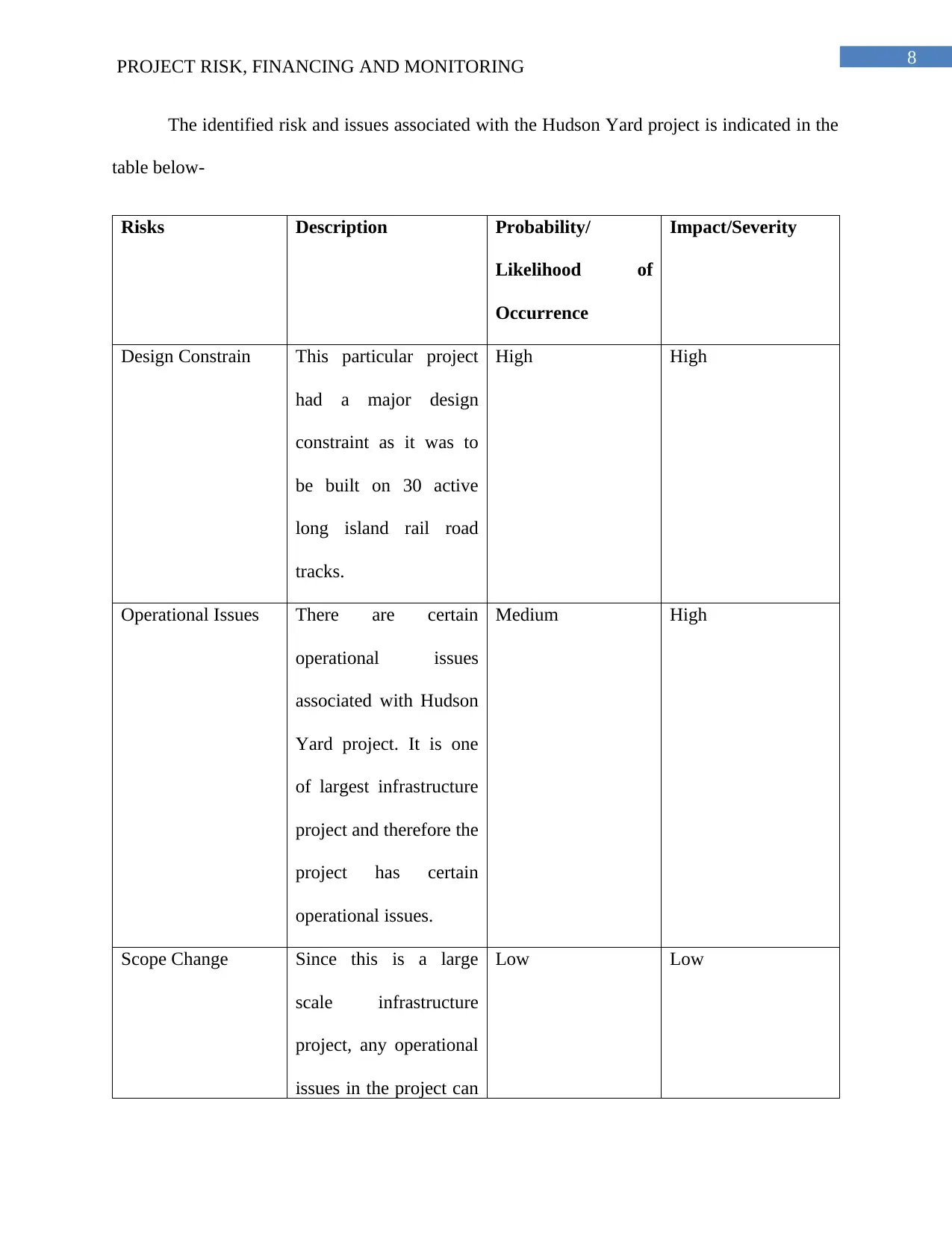
8PROJECT RISK, FINANCING AND MONITORING
The identified risk and issues associated with the Hudson Yard project is indicated in the
table below-
Risks Description Probability/
Likelihood of
Occurrence
Impact/Severity
Design Constrain This particular project
had a major design
constraint as it was to
be built on 30 active
long island rail road
tracks.
High High
Operational Issues There are certain
operational issues
associated with Hudson
Yard project. It is one
of largest infrastructure
project and therefore the
project has certain
operational issues.
Medium High
Scope Change Since this is a large
scale infrastructure
project, any operational
issues in the project can
Low Low
The identified risk and issues associated with the Hudson Yard project is indicated in the
table below-
Risks Description Probability/
Likelihood of
Occurrence
Impact/Severity
Design Constrain This particular project
had a major design
constraint as it was to
be built on 30 active
long island rail road
tracks.
High High
Operational Issues There are certain
operational issues
associated with Hudson
Yard project. It is one
of largest infrastructure
project and therefore the
project has certain
operational issues.
Medium High
Scope Change Since this is a large
scale infrastructure
project, any operational
issues in the project can
Low Low
⊘ This is a preview!⊘
Do you want full access?
Subscribe today to unlock all pages.

Trusted by 1+ million students worldwide
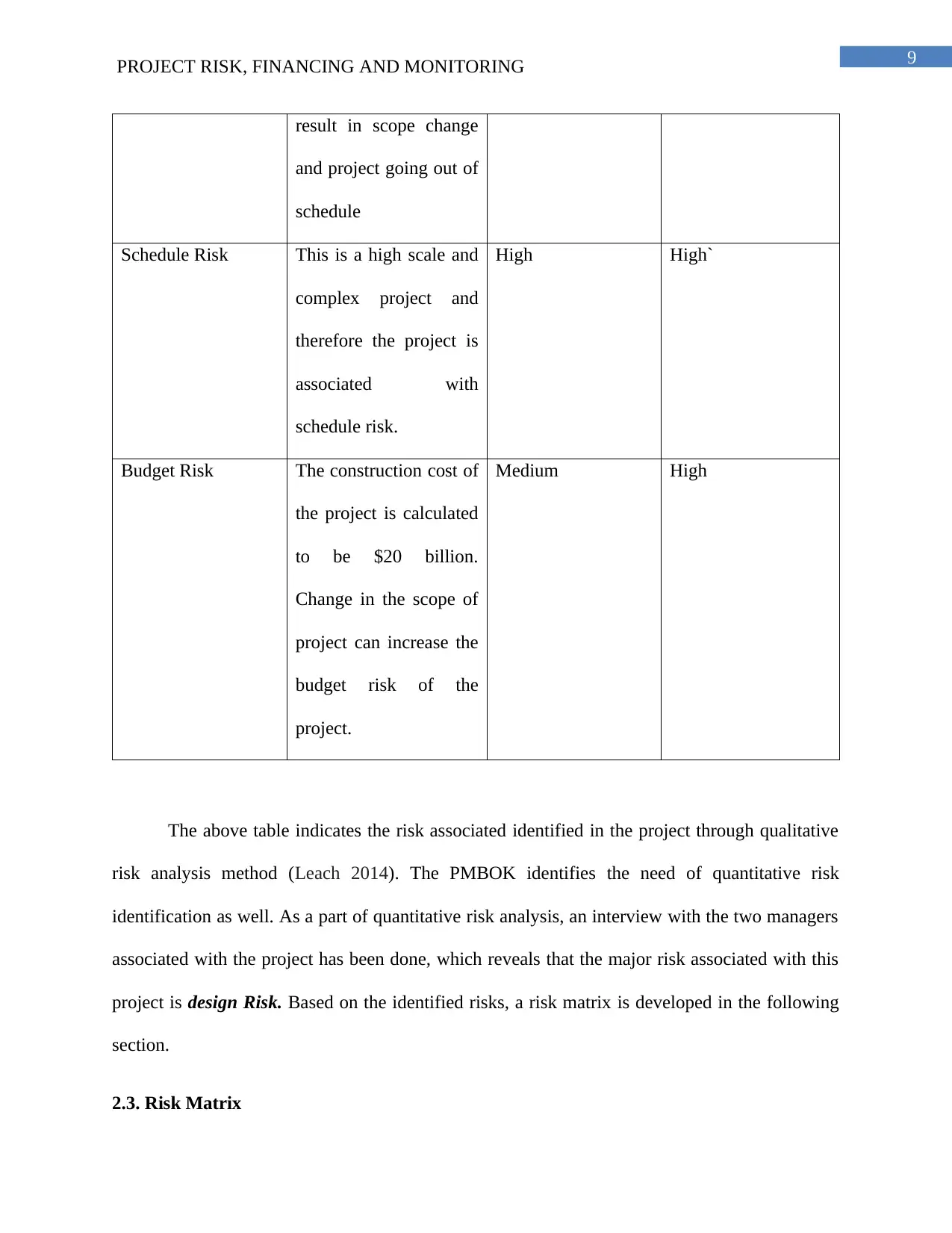
9PROJECT RISK, FINANCING AND MONITORING
result in scope change
and project going out of
schedule
Schedule Risk This is a high scale and
complex project and
therefore the project is
associated with
schedule risk.
High High`
Budget Risk The construction cost of
the project is calculated
to be $20 billion.
Change in the scope of
project can increase the
budget risk of the
project.
Medium High
The above table indicates the risk associated identified in the project through qualitative
risk analysis method (Leach 2014). The PMBOK identifies the need of quantitative risk
identification as well. As a part of quantitative risk analysis, an interview with the two managers
associated with the project has been done, which reveals that the major risk associated with this
project is design Risk. Based on the identified risks, a risk matrix is developed in the following
section.
2.3. Risk Matrix
result in scope change
and project going out of
schedule
Schedule Risk This is a high scale and
complex project and
therefore the project is
associated with
schedule risk.
High High`
Budget Risk The construction cost of
the project is calculated
to be $20 billion.
Change in the scope of
project can increase the
budget risk of the
project.
Medium High
The above table indicates the risk associated identified in the project through qualitative
risk analysis method (Leach 2014). The PMBOK identifies the need of quantitative risk
identification as well. As a part of quantitative risk analysis, an interview with the two managers
associated with the project has been done, which reveals that the major risk associated with this
project is design Risk. Based on the identified risks, a risk matrix is developed in the following
section.
2.3. Risk Matrix
Paraphrase This Document
Need a fresh take? Get an instant paraphrase of this document with our AI Paraphraser
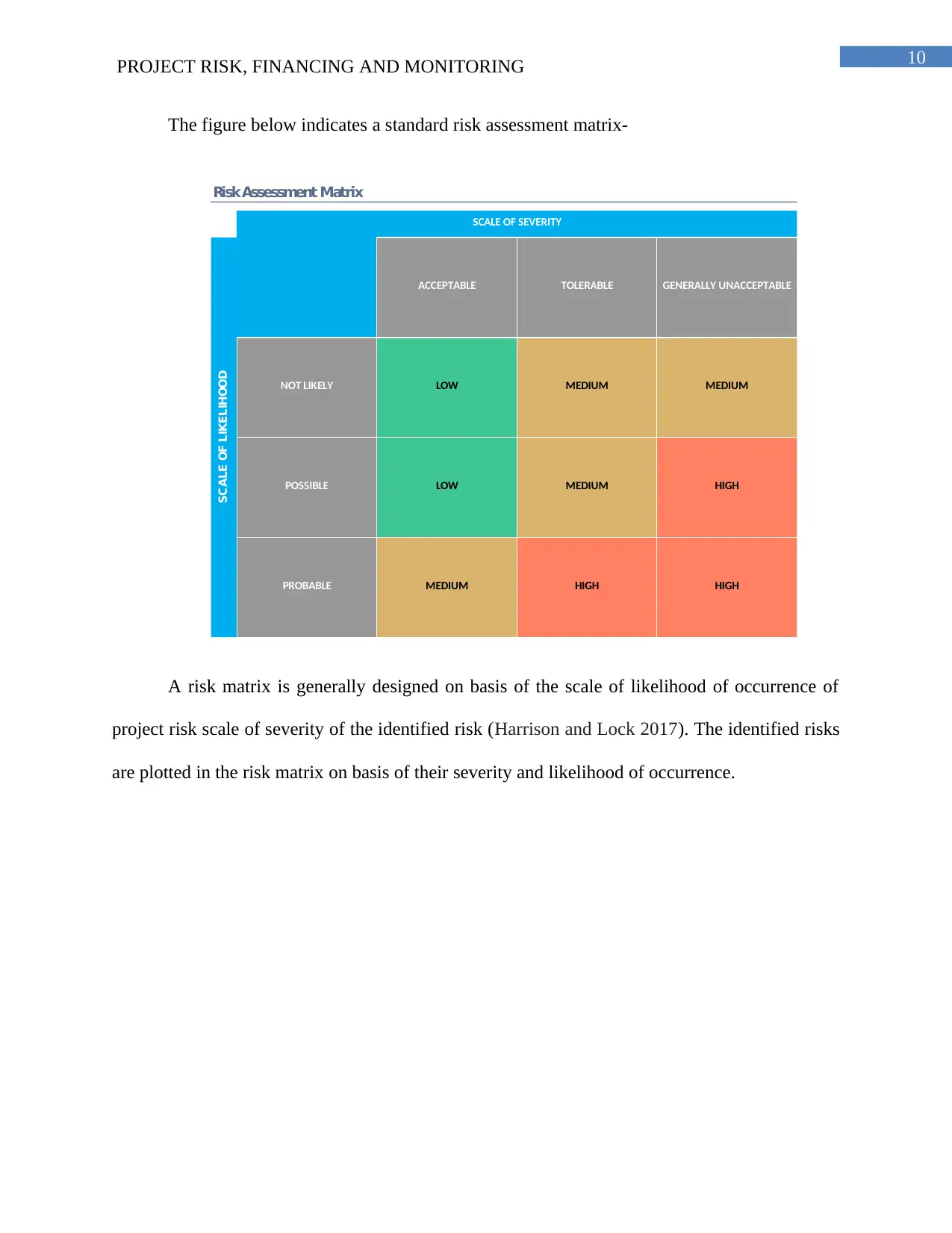
10PROJECT RISK, FINANCING AND MONITORING
The figure below indicates a standard risk assessment matrix-
Risk Assessment Matrix
ACCEPTABLE TOLERABLE GENERALLY UNACCEPTABLE
NOT LIKELY LOW MEDIUM MEDIUM
POSSIBLE LOW MEDIUM HIGH
PROBABLE MEDIUM HIGH HIGH
SCALE OF SEVERITY
SCALE OF LIKELIHOOD
A risk matrix is generally designed on basis of the scale of likelihood of occurrence of
project risk scale of severity of the identified risk (Harrison and Lock 2017). The identified risks
are plotted in the risk matrix on basis of their severity and likelihood of occurrence.
The figure below indicates a standard risk assessment matrix-
Risk Assessment Matrix
ACCEPTABLE TOLERABLE GENERALLY UNACCEPTABLE
NOT LIKELY LOW MEDIUM MEDIUM
POSSIBLE LOW MEDIUM HIGH
PROBABLE MEDIUM HIGH HIGH
SCALE OF SEVERITY
SCALE OF LIKELIHOOD
A risk matrix is generally designed on basis of the scale of likelihood of occurrence of
project risk scale of severity of the identified risk (Harrison and Lock 2017). The identified risks
are plotted in the risk matrix on basis of their severity and likelihood of occurrence.
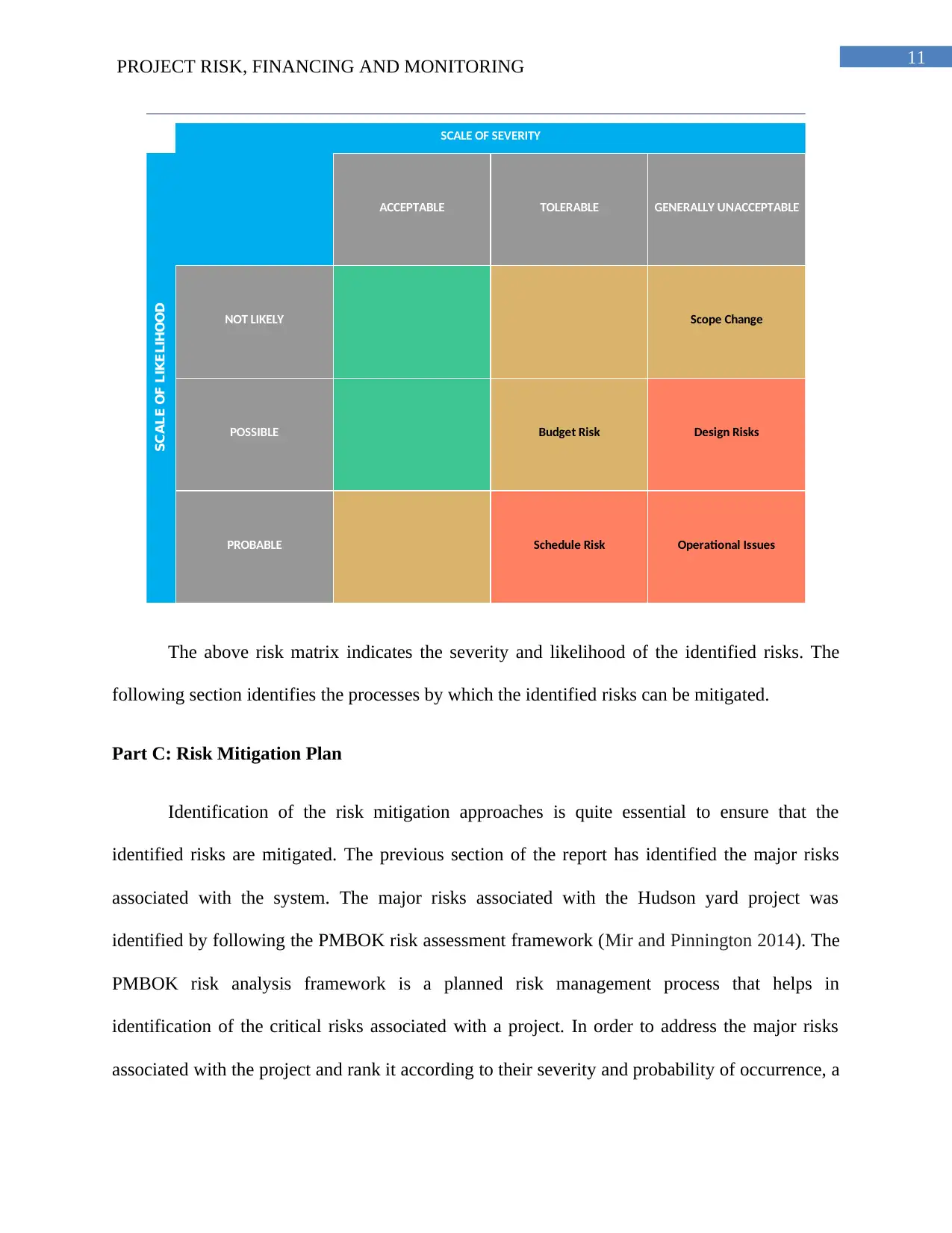
11PROJECT RISK, FINANCING AND MONITORING
ACCEPTABLE TOLERABLE GENERALLY UNACCEPTABLE
NOT LIKELY Scope Change
POSSIBLE Budget Risk Design Risks
PROBABLE Schedule Risk Operational Issues
SCALE OF SEVERITY
SCALE OF LIKELIHOOD
The above risk matrix indicates the severity and likelihood of the identified risks. The
following section identifies the processes by which the identified risks can be mitigated.
Part C: Risk Mitigation Plan
Identification of the risk mitigation approaches is quite essential to ensure that the
identified risks are mitigated. The previous section of the report has identified the major risks
associated with the system. The major risks associated with the Hudson yard project was
identified by following the PMBOK risk assessment framework (Mir and Pinnington 2014). The
PMBOK risk analysis framework is a planned risk management process that helps in
identification of the critical risks associated with a project. In order to address the major risks
associated with the project and rank it according to their severity and probability of occurrence, a
ACCEPTABLE TOLERABLE GENERALLY UNACCEPTABLE
NOT LIKELY Scope Change
POSSIBLE Budget Risk Design Risks
PROBABLE Schedule Risk Operational Issues
SCALE OF SEVERITY
SCALE OF LIKELIHOOD
The above risk matrix indicates the severity and likelihood of the identified risks. The
following section identifies the processes by which the identified risks can be mitigated.
Part C: Risk Mitigation Plan
Identification of the risk mitigation approaches is quite essential to ensure that the
identified risks are mitigated. The previous section of the report has identified the major risks
associated with the system. The major risks associated with the Hudson yard project was
identified by following the PMBOK risk assessment framework (Mir and Pinnington 2014). The
PMBOK risk analysis framework is a planned risk management process that helps in
identification of the critical risks associated with a project. In order to address the major risks
associated with the project and rank it according to their severity and probability of occurrence, a
⊘ This is a preview!⊘
Do you want full access?
Subscribe today to unlock all pages.

Trusted by 1+ million students worldwide
1 out of 17
Related Documents
Your All-in-One AI-Powered Toolkit for Academic Success.
+13062052269
info@desklib.com
Available 24*7 on WhatsApp / Email
![[object Object]](/_next/static/media/star-bottom.7253800d.svg)
Unlock your academic potential
Copyright © 2020–2025 A2Z Services. All Rights Reserved. Developed and managed by ZUCOL.




